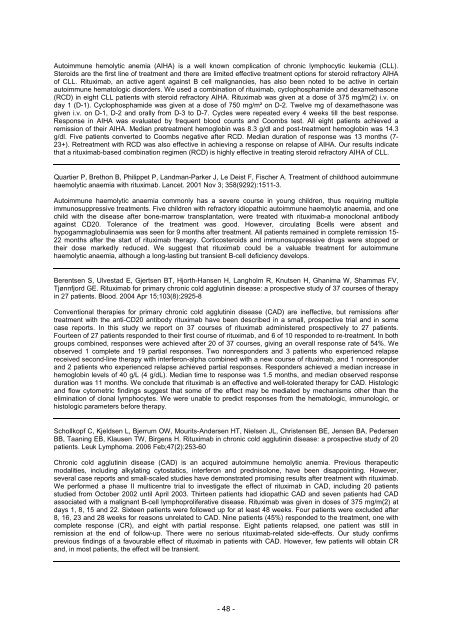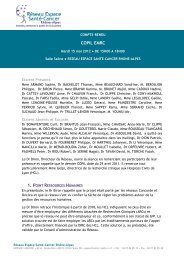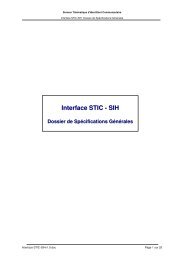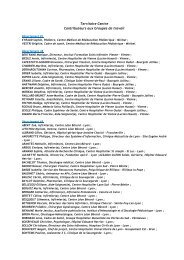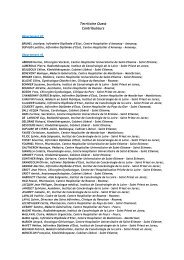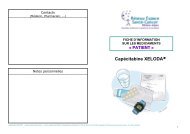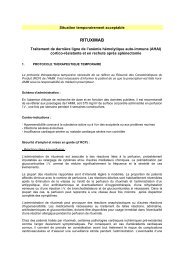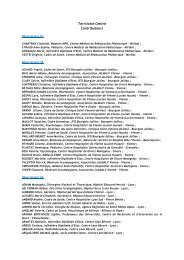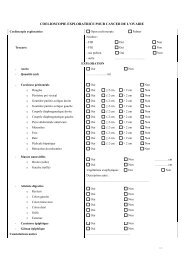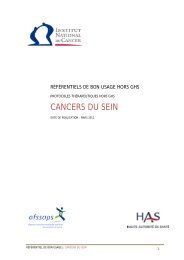rituximab
rituximab
rituximab
You also want an ePaper? Increase the reach of your titles
YUMPU automatically turns print PDFs into web optimized ePapers that Google loves.
Autoimmune hemolytic anemia (AIHA) is a well known complication of chronic lymphocytic leukemia (CLL).Steroids are the first line of treatment and there are limited effective treatment options for steroid refractory AIHAof CLL. Rituximab, an active agent against B cell malignancies, has also been noted to be active in certainautoimmune hematologic disorders. We used a combination of <strong>rituximab</strong>, cyclophosphamide and dexamethasone(RCD) in eight CLL patients with steroid refractory AIHA. Rituximab was given at a dose of 375 mg/m(2) i.v. onday 1 (D-1). Cyclophosphamide was given at a dose of 750 mg/m² on D-2. Twelve mg of dexamethasone wasgiven i.v. on D-1, D-2 and orally from D-3 to D-7. Cycles were repeated every 4 weeks till the best response.Response in AIHA was evaluated by frequent blood counts and Coombs test. All eight patients achieved aremission of their AIHA. Median pretreatment hemoglobin was 8.3 g/dl and post-treatment hemoglobin was 14.3g/dl. Five patients converted to Coombs negative after RCD. Median duration of response was 13 months (7-23+). Retreatment with RCD was also effective in achieving a response on relapse of AIHA. Our results indicatethat a <strong>rituximab</strong>-based combination regimen (RCD) is highly effective in treating steroid refractory AIHA of CLL.Quartier P, Brethon B, Philippet P, Landman-Parker J, Le Deist F, Fischer A. Treatment of childhood autoimmunehaemolytic anaemia with <strong>rituximab</strong>. Lancet. 2001 Nov 3; 358(9292):1511-3.Autoimmune haemolytic anaemia commonly has a severe course in young children, thus requiring multipleimmunosuppressive treatments. Five children with refractory idiopathic autoimmune haemolytic anaemia, and onechild with the disease after bone-marrow transplantation, were treated with <strong>rituximab</strong>-a monoclonal antibodyagainst CD20. Tolerance of the treatment was good. However, circulating Bcells were absent andhypogammaglobulinaemia was seen for 9 months after treatment. All patients remained in complete remission 15-22 months after the start of <strong>rituximab</strong> therapy. Corticosteroids and immunosuppressive drugs were stopped ortheir dose markedly reduced. We suggest that <strong>rituximab</strong> could be a valuable treatment for autoimmunehaemolytic anaemia, although a long-lasting but transient B-cell deficiency develops.Berentsen S, Ulvestad E, Gjertsen BT, Hjorth-Hansen H, Langholm R, Knutsen H, Ghanima W, Shammas FV,Tjønnfjord GE. Rituximab for primary chronic cold agglutinin disease: a prospective study of 37 courses of therapyin 27 patients. Blood. 2004 Apr 15;103(8):2925-8Conventional therapies for primary chronic cold agglutinin disease (CAD) are ineffective, but remissions aftertreatment with the anti-CD20 antibody <strong>rituximab</strong> have been described in a small, prospective trial and in somecase reports. In this study we report on 37 courses of <strong>rituximab</strong> administered prospectively to 27 patients.Fourteen of 27 patients responded to their first course of <strong>rituximab</strong>, and 6 of 10 responded to re-treatment. In bothgroups combined, responses were achieved after 20 of 37 courses, giving an overall response rate of 54%. Weobserved 1 complete and 19 partial responses. Two nonresponders and 3 patients who experienced relapsereceived second-line therapy with interferon-alpha combined with a new course of <strong>rituximab</strong>, and 1 nonresponderand 2 patients who experienced relapse achieved partial responses. Responders achieved a median increase inhemoglobin levels of 40 g/L (4 g/dL). Median time to response was 1.5 months, and median observed responseduration was 11 months. We conclude that <strong>rituximab</strong> is an effective and well-tolerated therapy for CAD. Histologicand flow cytometric findings suggest that some of the effect may be mediated by mechanisms other than theelimination of clonal lymphocytes. We were unable to predict responses from the hematologic, immunologic, orhistologic parameters before therapy.Schollkopf C, Kjeldsen L, Bjerrum OW, Mourits-Andersen HT, Nielsen JL, Christensen BE, Jensen BA, PedersenBB, Taaning EB, Klausen TW, Birgens H. Rituximab in chronic cold agglutinin disease: a prospective study of 20patients. Leuk Lymphoma. 2006 Feb;47(2):253-60Chronic cold agglutinin disease (CAD) is an acquired autoimmune hemolytic anemia. Previous therapeuticmodalities, including alkylating cytostatics, interferon and prednisolone, have been disappointing. However,several case reports and small-scaled studies have demonstrated promising results after treatment with <strong>rituximab</strong>.We performed a phase II multicentre trial to investigate the effect of <strong>rituximab</strong> in CAD, including 20 patientsstudied from October 2002 until April 2003. Thirteen patients had idiopathic CAD and seven patients had CADassociated with a malignant B-cell lymphoproliferative disease. Rituximab was given in doses of 375 mg/m(2) atdays 1, 8, 15 and 22. Sixteen patients were followed up for at least 48 weeks. Four patients were excluded after8, 16, 23 and 28 weeks for reasons unrelated to CAD. Nine patients (45%) responded to the treatment, one withcomplete response (CR), and eight with partial response. Eight patients relapsed, one patient was still inremission at the end of follow-up. There were no serious <strong>rituximab</strong>-related side-effects. Our study confirmsprevious findings of a favourable effect of <strong>rituximab</strong> in patients with CAD. However, few patients will obtain CRand, in most patients, the effect will be transient.- 48 -


